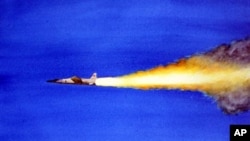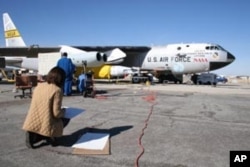One of the nation's most prolific art collectors is the U.S. space agency. For nearly a half-century, NASA has commissioned artists to document its missions and projects. Seventy of the 3,000 works in its collection are in a traveling exhibit at the National Air and Space Museum in Washington.
The art is mounted in a quiet corner gallery on the second floor of this cavernous museum, perched above an atrium filled with hanging spacecraft and missiles and crowds of visiting tourists. The show retraces milestones in space history through the unique visions and sensibilities of a diverse group of artists.
“The whole collection leaves me with this wonderful artistic notion of what we’ve been through over the 50 years of NASA history," says curator Tom Crouch, "from the very first launches, down to the latest planetary probe, and you see it through the eyes and the experience of these artists, all different, all interested in some different aspect of this, and yet when you see it here in the gallery it all comes together.”
As you enter the gallery, you come face-to-face with a life-size portrait of astronaut Gordon Cooper by Mitchell Jamieson. It is 1963 and Cooper, in his silver-colored spacesuit, steps out of his Mercury space capsule after 22 orbits of Earth onto the bright sunlit deck of the recovery ship.
Nearby is a large painting by famed American illustrator Norman Rockwell of two astronauts suiting up for the first flight of the Gemini program in 1965.
“It’s like two knights putting on their armor going out to do battle," Crouch says. "We have another Rockwell called ‘Behind Apollo 11’ that is nothing but faces in profile, from the three Apollo 11 astronauts, to the backup crew, to their wives, to scientists, engineers and managers who stood behind them and helped them get to the moon.”
A range of works in the show are inspired by the Apollo program which, as President John F. Kennedy envisioned, successfully landed the first men on the Moon in July 1969. The program carried five more crews to the lunar surface before ending in 1972.
Pop artist Andy Warhol captures the iconic image of Neil Armstrong’s first steps on the lunar surface in vivid neon pink, yellow and blue. And, oil painter Robert McCall imagines the sight of the rocket engine firing to propel the lunar lander back to earth.
Crouch says artist Crystal Jackson shows spectators watching the historic events unfold. “The Crystal Jackson in the show is called ‘The Moon Hut’ and it was a hamburger place outside the NASA main gate with a big moon and these wonderful characters who were down there drawn by the excitement of this program.”
The show also includes photographs by William Wegman, known for his Weimaraner dog portraits, here suited-up as astronauts peering out from the portholes of the International Space Station.
And high overhead there’s a twisted rubber sculpture made from tire fragments called “Remembering Columbia,” that evokes the loss of the Columbia Space Shuttle and its crew in a disastrous reentry accident in 2003.
Another commissioned piece by watercolorist Barbara Ernst Prey is the X-43, the fastest airplane in the world, clocked at more than 11,000 kilometers per hour. Prey studied the craft for months and did sketches at Edwards Air Force Base in the California’s Mojave Desert an hour before its launch from the wing of a high-flying carrier jet.
“What was going through my mind is: Do I make this abstract? Do I make it concrete?" says Prey. "It kept on coming to me. It’s really about the blue sky and this object going as fast as it can across and just the energy. And that’s what I tried to get with the yellow and the different colors in the cloud going behind it.”
Prey stationed herself in front of a large TV screen to watch the flight. She says the experience filled her with a sense of awe. “It’s the amazing gifts that these people have to do amazing things, and I think that’s what I’ve really learned. And it helps you look differently because you are looking and you are thinking of the cosmos and universe and that helps you look at things differently.”
Visitor Barbara Baldwin from San Antonio, Texas shares that enthusiasm. “You know, growing up with space exploration was a neat thing,"she says. "I’ll never forget where I was when the men landed on the moon and what we did that day. Our family gathered around the TV that night. So I have great memories as a child.”
Hunter Thorton from Vidalia, Louisiana, came to the museum with some high school friends. He says it was a chance to put on his "Star Wars" movie gear. He is a fan of science fiction, but likes how the artists in this show interpret real events. “It really goes to show how America is propelling in technology and being in space. And hopefully one day we’ll be walking in costumes likes this for real.”
“NASA Art: Fifty Years of Exploration” was originally slated to make its last stop at the National Air and Space Museum in Washington. But popular demand for the show has extended its journey into 2012.

















